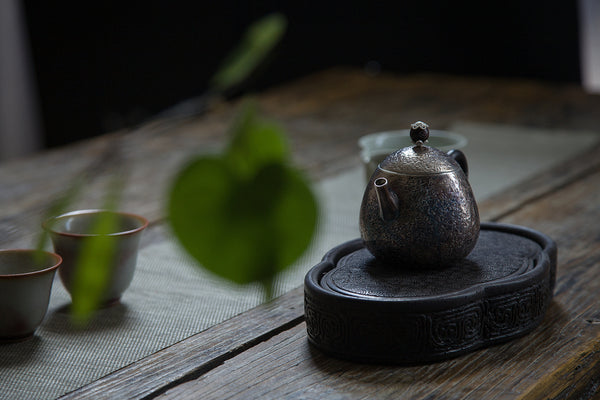Aside from their steep price tag (we’re talking $500+ for one teapot), what is it that has people buying silver teapots for gong fu cha? With Yixing clay, porcelain, glass, and cast iron, there's plenty of teaware to choose from. So is the pure silver teapot really worth it?

What Is A Silver Teapot?
A silver teapot is a small teapot designated for Gong Fu style tea, made entirely out of silver (not coated but solid material inside and out). Silver teapots are mostly crafted in Yunnan, China, Taiwan, and some in Japan.
Which Teas Brew Best In A Silver Teapot?
One of the qualities of silver is that it is stable in water. Thus, in comparison to clay teapots, silver will not transform the actual taste of tea. The brew from a silver teapot is more true to the taste of the tea leaves.
We’ve learned that unlike other types of teaware that has more or less general guidelines as to which teas to brew, with silver teapots it varies significantly with the consumer.
The first thing to note is to use good quality loose leaf teas.
Light teas with intriguing characteristics could be an excellent place to start. These could be both light oolongs and green teas. Raw pu-erh and aged white teas also show an unusual side with silver teapots. On the other hand, heavy dark teas like ripe pu-erh, black tea, hei cha, and heavily roasted oolongs usually aren’t as pleasing. (However, we have also heard the opposite. Experimenting is the key!)
If you have teas where you experienced interesting tastes or aromas gently peaking through, and you would like to see if they can be brought more to the surface — try brewing them in a silver teapot!
Also, if you have teas that can be brewed multiple times, going past 10-15, try using a silver teapot. Silver is the type of material that has the highest thermal conductivity properties. At the same time, it is good at retaining heat due to low thermal emittance. Just make sure to pre-heat your silver teapot before brewing tea in it.

The Pros And Cons Of A Silver Teapot
Pros:
- good to go from day one — no seasoning needed
- doesn’t absorb flavors like yixing clay — can be used with any tea
- sturdy — suitable for traveling, will never break, and will last many lifetimes!
- retains heat well – easier to control water temperature and thus the brew.
- overall easier to brew with — over-steeping, or using higher temperatures won’t harm the tea
Cons:
- lid doesn’t fit as tightly as with yixing teapots
- bitterness can also become heightened
- shouldn’t be used with chenpi teas or any citrusy teas — acids in citruses might have a slight corrosion effect on silver
- might be too hot to handle
We would say that silver teapots should be used by people who are seriously sure about both the quality and taste of their tea. An expensive teapot as this one could only be matched with tea of similar quality (doesn't necessarily mean that it has to be as expensive).
A silver teapot will bring an already fantastic tea to a whole new level. However, if the tea is just alright, well, a silver teapot will most likely bring to the surface its not so favorable qualities.
Notes On Using A Silver Teapot:
- To clean a silver teapot, wash it with hot water and a neutral, ammonia- and acid-free dish soap. You can use a cellulose dish sponge to remove stains or residues if any. For more stubborn tarnish, line a pot with aluminium foil, fill it with water and boil it, while dissolving a spoonfull of soda bicarbonate and salt in it. Submerge your silver teapot and let sit for 30 minutes. An electro-chemical reaction will remove all the tarnish from your teapot. After taking it out, wipe with a clean cloth.
- Because in a silver teapot tea leaves brew at a faster rate, we recommend using slightly fewer tea leaves than usual. The brew will still come out as concentrated.
- Furthermore, if you are used to gong fu cha with your yixing or porcelain teapots, which have a lower heat conductivity, be wary not to get burned by the hotter temperature of a silver teapot!
- Before purchasing a silver teapot, try finding a friend or perhaps a tea shop that already has one. Try it out once or twice before investing. Some people get desired results by buying silver gong fu cups, rather than a whole teapot, thus saving money.
Check out our "silver" tag to learn more about silver teaware.